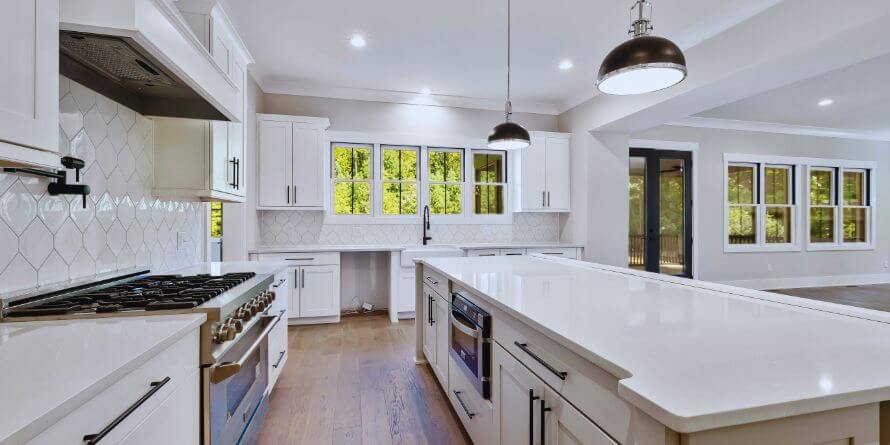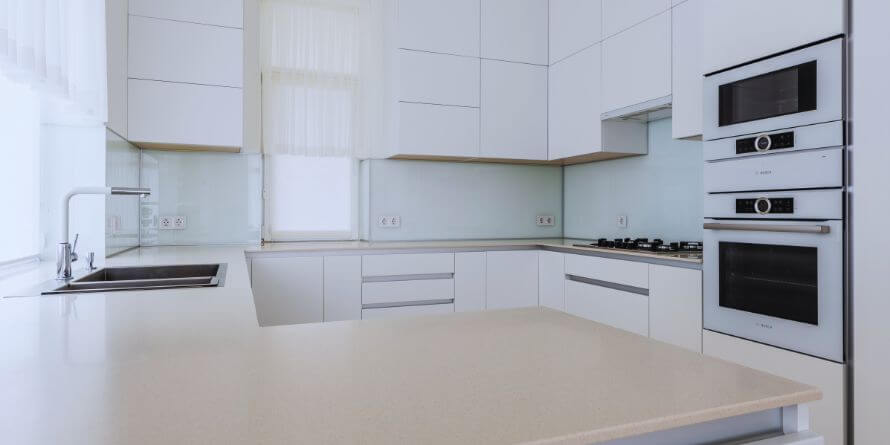While searching for the standard height of kitchen countertops, it is crucial to first understand the importance of what is the standard height of countertops in kitchen.
Although it seems a small and negligible aspect of kitchen remodeling and designing, it still matters a lot. But why? A standard height, not too high nor too low, boosts the cooking process, providing comfort while washing your dishes, cutting vegetables, and making dough.
It prevents cumbersome and irritation during the process and fits everything, including all the kitchen appliances and cabinetry, in the right place.
It also prevents the shoulder and back strain caused by accessing the cooking accessories placed beyond the body limit. Let’s explore the standard size of kitchen countertops and ergonomic rules in detail.
What Is The Standard Height Of Countertops In Kitchen?
Explore the average height of kitchen countertop, the standard height between the kitchen worktop and wall unit, and the standard kitchen countertop height and depth to make an informed decision.

Standard Height of Kitchen Countertops
The standard height of kitchen countertops is a commonly acceptable height designed for an average user’s comfort and smooth functionality.
It commonly settles around 36 inches from the floor. Most users can conveniently perform all their cooking tasks at this height without suffering back pain.
Ergonomic Principle Of 36 Inches
Now the question is, why standard kitchen counter height in cm is 91.44 or in inches is 36? Well. this standard has been settled by ergonomics principles. Ergonomic is a branch of design that aims at structuring construction to provide maximum convenience and comfort to the user.
Ergonomics set this 36 inches as a kitchen height standard for countertops because it accommodates an average user’s waist level and ultimately prevents the user from too much bending.
A user should not bend his/her elbows more than 90 degrees for too long. Otherwise, it causes some internal injuries and muscle fatigue, and this 36-inch height is the best option to prevent it.
Compatibility Of Kitchen Appliances
Besides kitchen counterparts, the majority of electrical and non-electric kitchen appliances are also well-settled with this 36-inch height. For example, dishwashers, ovens, dish racks, and other utensil racks are designed according to this ergonomic principle for better and practical use.
Customization
However, the standard height of the kitchen worktop can also be customized up to 39 inches or more for those users who are a bit extra tall or 34 inches or a bit lower for those who are extra small.
The height can also be changed according to the user’s cooking habits, kitchen layouts, kitchen purpose, and user preferences. For example, if the kitchen is specified only for dishwashing, then a bit higher countertops are more beneficial.
On the other hand, if the user is a backing lover, then the lower height of countertops is appreciated to get maximum results.

Impact on Kitchen Design
A consistent height of all the kitchen countertops represents harmony between different kitchen elements, which boosts the aesthetic appeal, and makes your kitchen look more organized and planned.
Similarly, the standard size of kitchen worktops also defines a kitchen’s look, e.g., whether it is based on a modern or traditional theme. Usually, the height is kept low in traditional and antique designs, while modern designs prefer a high height.
But again, you can divide your kitchen into different functionality zones by keeping varying heights of different countertops. For example, you can keep the bar area countertops’ height even more than 36 inches while backing area countertops’ height is lower than 36 inches.
Tips & Considerations For Standard Height Of A Kitchen Countertop
- Instead of just blindly following the ergonomic rules for the standard height of kitchen countertops, keep in mind your height. As every person varies in height, choose the height you feel most comfortable when you cook in the long run.
- Besides this, you can also ask to add an adjustable furniture foot which can raise your countertop height upon demand.
- You can also follow a multi-tiered island in your kitchen countertops design and construction, in which you keep half of the countertops at a low height while the rest are at a bit upper height.
- Another rule of thumb, besides this normal height for kitchen counters, is the creation of shallow countertops in smaller kitchens. In comparison, deeper ones in larger kitchens help you effectively utilize the available space.

FAQs what is the standard height of countertops in kitchen
What is the best height for kitchen counters?
According to ergonomic principles, the best height for kitchen counters should be around 36 inches from the floor. However, it’s not a rule of thumb. The user can change the height according to his needs, preferences, and kitchen size.
What is the code for kitchen counter height?
There is no specific code for the kitchen counter height. Still, IRC and NKBA set the most preferred ergonomic height, 36 inches, which is considered feasible for most users worldwide, depending on the current human body height.
What is the standard height and depth of kitchen countertops?
While the standard height is 36 inches, the standard depth is considered around 25 inches. However, a user can do minor ups and downs in measurement depending on the kitchen size and required space.
What is the normal height between the countertop and upper cabinets?
The standard height between these two is usually considered around 18 inches which provides ample space for the effective use of different kitchen appliances. However, if you do not consider appliances, you can set the height according to your choice.
Final Analysis
What is the standard height of countertops in kitchen? following the standard height of kitchen cabinets with countertop rules in your kitchen construction and remodeling not only helps you avoid discomfort and prevent health issues but also makes your kitchen accessible and easy for everyone, especially your guests.
Besides this convenience, you also prevent the penalties, fines, and adverse circumstances from not following the standard local building community codes.
It also boosts the looks and appeal of your kitchen, creating harmony. Similarly, following standard kitchen counter height construction rules also helps you utilize your kitchen space more effectively, depending on your kitchen size.
But remember to consult a professional architect before you plan your kitchen construction or remodel.
He will help you better understand your needs, set the countertop’s height accordingly, and guide you in choosing the most appropriate theme and color pattern for your kitchen and the whole house.
Read our related article: Do you need a permit to remodel a kitchen?

